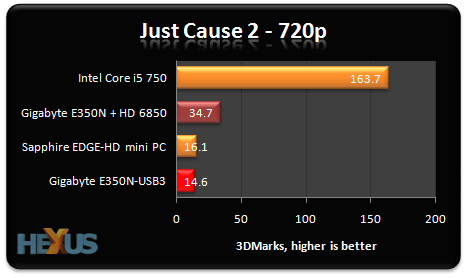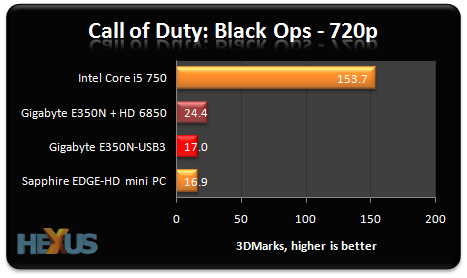Testing the DX11 GPU
Two sets of results for the Gigabyte board here. The bright-red bar indicates performance from the onboard Radeon HD 6310 IGP, while the darker bar shows what happens when I place a Radeon HD 6850 1GB card in the x16 PCIe slot.
Hmm, the Radeon HD 6310 graphics trail NVIDIA's ION 2 in this basic test of DX9 goodness. Strap in a Radeon HD 6850 card and performance jumps by 2.5x, though, as you can see, having a Core i5 750 back-up the card translates to a significantly higher score.

Dialling in-game settings down to a 1,280x720 resolution and low-quality detail, making the game rather ugly, neither the Radeon HD 6310 nor NVIDIA ION 2 are much good at pushing out acceptable frame-rates. Stick in a decent mid-range graphics card and the anaemic nature of the Bobcat cores presents itself; they simply don't have the oomph to drive a modern graphics card.

And that situation is replicated in Call of Duty: Black Ops, where there's scant increase in the frame-rate when switching from IGP to a discrete card.
Tuning the games to high-quality settings and running at a 1,680x1,050 resolution, the Core i5 750 returns average frame-rates of 46.5fps and 83.1fps for Just Cause 2 and COD: Black Ops, respectively. Switching on over to the Gigabyte board and these dip to 24.5fps and 20.5fps, respectively - not good enough for smooth gameplay.
You're not going to be able to play fast-paced games at fluid frame-rates, no matter which graphics card is used; the E-350 chip simply doesn't have enough horsepower to cut it, which means the DX11 part of the spec. isn't particularly useful for rendering graphics. Rather, one will need to look at the DirectCompute part of DX11 to get the best out of the Radeon HD 6310 GPU.









